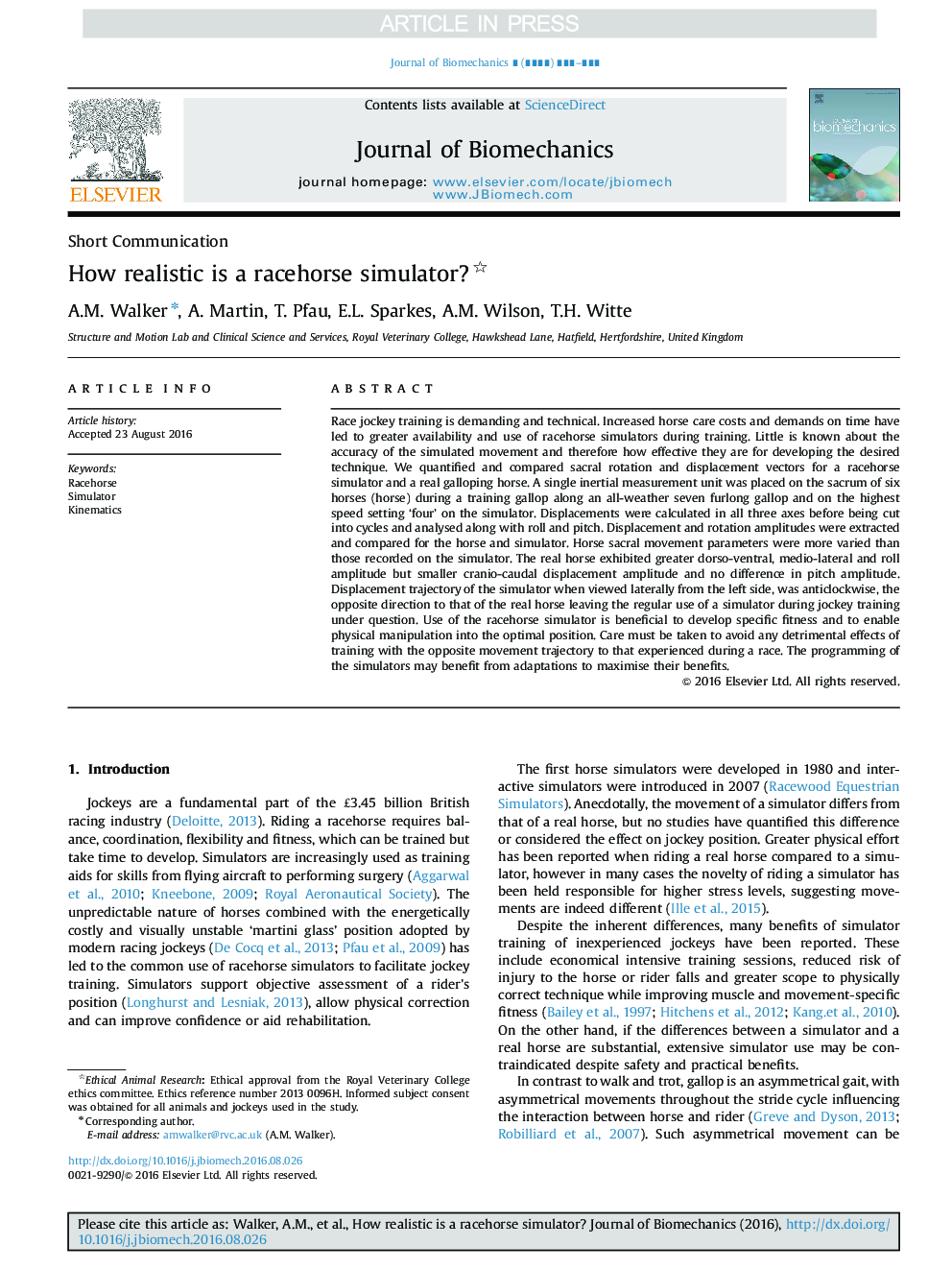| کد مقاله | کد نشریه | سال انتشار | مقاله انگلیسی | نسخه تمام متن |
|---|---|---|---|---|
| 5032573 | 1369985 | 2016 | 6 صفحه PDF | دانلود رایگان |
عنوان انگلیسی مقاله ISI
How realistic is a racehorse simulator?
ترجمه فارسی عنوان
شبیه ساز اسب سواری چقدر واقع بینانه است؟
دانلود مقاله + سفارش ترجمه
دانلود مقاله ISI انگلیسی
رایگان برای ایرانیان
ترجمه چکیده
آموزش مسابقات جویکی خواستار و فنی است. افزایش هزینه های مراقبت از اسب و تقاضای آنها در زمان، باعث افزایش دسترسی و استفاده از شبیه ساز های اسباب بازی در طول آموزش می شود. اندکی در مورد دقت جنبش شبیه سازی شده شناخته شده است و از این رو برای توسعه تکنیک مورد نظر بسیار موثر است. ما مقادیر چرخش و جابجایی ساکر را برای یک شبیه ساز اسباب بازی و یک اسب پرشور واقعی مقایسه و مقایسه کردیم. یک واحد اندازه گیری درونی مجهز به یک شل اسب (اسب) در طول یک پرش آموزشی در امتداد یک هلیکوپتر هفت فرولون تمام آب و در بالاترین سرعت تنظیم "چهار" در شبیه ساز قرار گرفت. جابجایی ها در هر سه محور محاسبه گردید تا قبل از اینکه به چرخه برسد و با رول و زمین تجزیه و تحلیل شد. دامنه جابجایی و چرخش برای اسب و شبیه سازی استخراج و مقایسه شد. پارامترهای جنبش اسرار ساحلی بیشتر از آنچه که در شبیه ساز ثبت شده بود متفاوت بود. اسب واقعی نشان دهنده دامنه بیشتر درشتی، مریضی و رول، اما دامنه جابه جایی کوچک تر از حد مجاز است و هیچ گونه تفاوت در دامنه امتداد وجود ندارد. مسیر جابجایی شبیه ساز در هنگام مشاهده از سمت چپ از سمت چپ، به سمت عقب، جهت مخالف نسبت به اسب واقعی است که استفاده منظم از یک شبیه ساز را در طول سوارکاری سوار انجام می دهد. استفاده از شبیه ساز مسابقه اسباب بازی مفید است برای توسعه تناسب خاص و برای فعال کردن جابجایی فیزیکی به موقعیت مطلوب. مراقبت باید برای جلوگیری از هر گونه اثرات زیان آور آموزش با مسیر حرکت مخالف نسبت به تجربه در طول مسابقه گرفته شود. برنامه نویسی شبیه سازها ممکن است از سازگاری ها برای به حداکثر رساندن مزایای آن سود ببرد.
موضوعات مرتبط
مهندسی و علوم پایه
سایر رشته های مهندسی
مهندسی پزشکی
چکیده انگلیسی
Race jockey training is demanding and technical. Increased horse care costs and demands on time have led to greater availability and use of racehorse simulators during training. Little is known about the accuracy of the simulated movement and therefore how effective they are for developing the desired technique. We quantified and compared sacral rotation and displacement vectors for a racehorse simulator and a real galloping horse. A single inertial measurement unit was placed on the sacrum of six horses (horse) during a training gallop along an all-weather seven furlong gallop and on the highest speed setting 'four' on the simulator. Displacements were calculated in all three axes before being cut into cycles and analysed along with roll and pitch. Displacement and rotation amplitudes were extracted and compared for the horse and simulator. Horse sacral movement parameters were more varied than those recorded on the simulator. The real horse exhibited greater dorso-ventral, medio-lateral and roll amplitude but smaller cranio-caudal displacement amplitude and no difference in pitch amplitude. Displacement trajectory of the simulator when viewed laterally from the left side, was anticlockwise, the opposite direction to that of the real horse leaving the regular use of a simulator during jockey training under question. Use of the racehorse simulator is beneficial to develop specific fitness and to enable physical manipulation into the optimal position. Care must be taken to avoid any detrimental effects of training with the opposite movement trajectory to that experienced during a race. The programming of the simulators may benefit from adaptations to maximise their benefits.
ناشر
Database: Elsevier - ScienceDirect (ساینس دایرکت)
Journal: Journal of Biomechanics - Volume 49, Issue 14, 3 October 2016, Pages 3570-3575
Journal: Journal of Biomechanics - Volume 49, Issue 14, 3 October 2016, Pages 3570-3575
نویسندگان
A.M. Walker, A. Martin, T. Pfau, E.L. Sparkes, A.M. Wilson, T.H. Witte,
